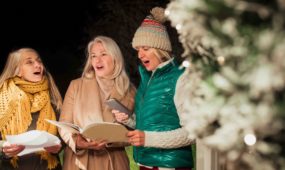Now thank we all our God
Hymns
Scott Malcolmson takes a look at the hymn Now thank we all our God, by German composer Martin Rinkart: “a great hymn of praise and of trust in God”

As we stand on the threshold of a new year, it is perfect to look at this great hymn of praise and of trust in God.
The hymn is in the form of a chorale, which were sung in Germany for centuries. They were sung in church and home, in the streets by choirs, and by the watchman as he did his rounds. This one has been used in Germany and began as a simple grace before family meals in the author’s home.
It is thought that it was printed in the first edition of Martin Rinkart’s Jesu Herz Buechlein of 1636.
The first two verses were the grace, based on Ecclesiasticus 50.22-24, to which the third verse, a paraphrase of the Gloria, was added before its publication (1636).
The first two stanzas of Martin Rinkart’s hymn are based on the doxology from Sirach:
“Now therefore bless ye the God of all,
which only doeth wondrous things everywhere,
which exalteth our days from the womb,
and dealeth with us according to his mercy.
He grant us joyfulness of heart,
and that peace may be in our days in Israel for ever:
That he would confirm his mercy with us, and deliver us at his time.”
The text from Ecclesiasticus was chosen by the Elector of Saxony to be used by preachers at thanksgiving services in churches after the Peace of Westphalia 1648 ended the disastrous Thirty Years’ War; and Rinkart’s hymn was a natural choice for the occasion.
Advertisement
It was fitting that it should be so, since the author had had long and bitter experience of the hardships of war.
His hymn was written when he was pastor of the walled town of Eilenburg, Saxony, a haven for many people who fled the war, bringing with them the plague and, over-taxing the town’s resources, exacerbating famine and disorder, as the town was also sacked three times by different armies.
Remarkably, after some nineteen years of ministering in these circumstances, Rinkart was yet able to publish the volume containing this outpouring of praise and thanksgiving.
For some time he was the only pastor in the town, and in the great plague of 1637 he often had to read the funeral service over forty or fifty of the dead at once.
In all, he ministered at the burial of nearly 5,000 people; but at last, the death-toll reaching 8,000, including his first wife, the task became too great and the dead had to be buried in trenches without a service.
Advertisement
The thought of this faithful pastor, frail in physique but heroic in service, ministering to such distress and courageously facing lawless bands, gives great poignancy and resonance to his famous hymn.
It is sung in translation, especially at the close of worship services and at special times of thanksgiving, throughout Christendom.
Catherine Winkworth’s English translation appeared in 1858.
The tune Nun Danket has been the ‘proper’ tune for this hymn since the words and melody appeared together in 1647. Johan Sebastian Bach used the melody in Cantatas 79 and 192, and wrote two other harmonisations.
Our current tune is based on a setting by Felix Mendelssohn in the last movement of his 1840 Symphony No. 2 in B-flat major, Op. 52 (Lobgesang, ‘Hymn of Praise’).
As the words in the second verse declare, which perfectly proclaim the beginning of a new year:
“Oh, may this bounteous God through all our life be near us,
With ever joyful hearts and blessed peace to cheer us”





